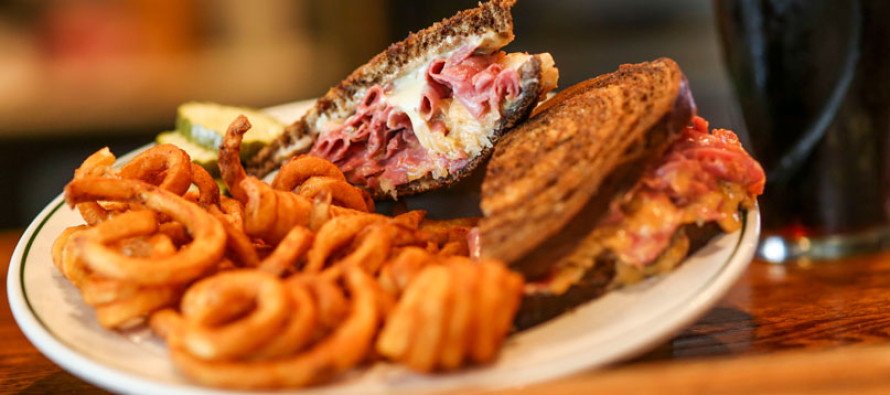Reuben, a Masque of Sandwich

A good sandwich can be an emotional thing. A good grilled sandwich, even more so. Sidle up to a Reuben sandwich and just look at it: lightly toasted rye bread, homemade sauerkraut, a hand’s width slab of salty, thin-sliced corned beef, melted Swiss cheese and a bizarre schlop of Russian salad dressing (dare we call this sauce special?).
Unlikely, ungainly – and arguably unhealthy, this sandwich is either a freak of genius or devilry. One is tempted to call it destiny, or a delicious roll of the dice, but the true beginning of the Rueben sandwich is, I think, difficult to shed light on. Its history shrouded in dark nights, dark times and dark needs.
Take yourself back to the depression – especially if you’re on a low-salt diet, you might as well. On a dark and stormy night, or a rain soaked spring evening (you pick) in New York, a shivering actress wrung out from takes in one of Charlie Chaplin’s stunt-filled films, totters into Reuben’s New York Deli on Park Avenue. The little lady is starving. Quite literally, she looks like she hasn’t eaten in days.
She says something to the chef, more exhausted than pleading, like, “Mr. Rueben, give me sandwich, I could eat an elephant.” And someone (not Reuben, he was off tallying up tickets or something) grabs slices of roast turkey and Virginia ham (very possibly the dregs of a night’s dinner service) and piles them onto some rye bread (cheaper than white) and Swiss cheese (imported but perhaps also left over) with a hay-forkful of coleslaw (ubiquitous in New York delis) and serves it up as a lumberjack’s midnight snack that could choke a horse.
She tucks in and dusts the empty plate with her wrists. In a literal minute, this hollow-cheeked starlet has engulfed the entirety of something so monstrous, it might have been intended as a sort of gastronomic dare. “That was the best sandwich I’ve ever eaten,” she declares (hopefully, having dabbed her lips and re-applied the color) and thus one legend of the Rueben was born.
It makes for dramatic food history, but like the story of the Hope Diamond or how Uncle Bruce saw a Bigfoot, the versions differ in the telling. Let’s now pay a visit to the Blackstone Hotel in Omaha, Nebraska. It’s the late 1920s and The Blackstone is a well-heeled – but possibly morally corrupt – hotel down on Farnam Street. It was meant to impress, and was a magnet to anyone who wished to be known but not seen (comparisons with Dorothy Parker and the Algonquin Hotel in NY are strictly optional here).
The chef de cuisine of the small restaurant is Lithuanian, or classically trained or else he is completely mad; the diners are late-night card players and their ilk. A poker game is in abeyance, pot money is collected, and the players herd towards the kitchen. Red-eyed and possibly lubricated with spirits, they ask for corned beef with sauerkraut. Someone named Reuben (or Reubin or Rubin) Kulakofsky (or Kulakowsky, or Kay), who is Lithuanian or Russian, is insistent about a sandwich and the ingredients, and voila! Corned beef, kraut, Swiss cheese and Russian dressing on rye: a Rueben is born. One original player named Schimmel, whose father later put the thing on the Blackstone menu, went on to publish a recipe in a local Omaha collection. Nebraska menus feature the same recipe under the same name, and everyone in Nebraska agreed that the Reuben began right here.
To me these stories feel surreal, like some hideously time-distorted John Galt encounter turned fable. It’s hard to know what to believe. Even now, New York Times writers, distant relatives, dictionary editors and food historians are at loggerheads. Sides have been picked and culinary knuckles cracked. Arguments have escalated to near fistfights over the Reuben’s provenance, and there is a good deal at stake. After all, it became the most popular sandwich in the nation, some say the world.
Ask yourself, what other sort of food is so culturally stoked, so daringly faddish that it has not one but two origin fables that evoke Edward Hopper’s famous painting, Nighthawks, with its lit diner and dark streets? How to make sense out of such mythology? Like Grimm’s Fairy Tales, these evoke primal fear, lust and envy, but where’s the kernel of truth?
For our analysis, we can borrow a tool from language studies (just like the Grimm brothers, who did fascinating work that established basic precepts such as consonant shifts). There is a saying among linguists: earliest spread is oldest bred. And for me, this tilts things strongly towards Omaha and the Blackstone Hotel, merely from the Reuben’s early Midwestern popularity and the spread of its name as a household word. A Rueben sandwich appears early on in many places around Omaha in its current conception, while the New York version only appears later, and after it had gained some renown.
But consider the draw of the first story. A sultry actress and Charlie Chaplain (who at the time was more famous than the Beatles), it’s late at night, she’s knackered and in a kind of Jewish-grandmother-crazed frenzy. A New York Deli chef makes a pile of sliced turkey and ham with slaw, cheese, and Russian dressing. However, Russian dressing is in the proper realm of the Rueben, and the Reuben Kulakofsky mentioned in the Omaha story was … remember … Russian.
There’s just one problem: Russian dressing isn’t really Russian. It was developed in freaking New Hampshire by a grocer named Colburn who was also, um, not Russian. But whatever! It did offer a spicy alternative to the popular French dressing (also a tomato, mayo, pickle sauce) with some horseradish thrown in. So both the Blackstone and Reuben’s Deli would both easily have had Russian dressing in their larders (or in their unused table caddies). So the dressing itself isn’t indicative of who has dibs. We’ll come back to that in a sec.
Rye bread was common fare in both delis and restaurants, especially with Eastern European crowds. As for corned beef… in my musty 1887 version of The White House Cook Book (which contains one whole chapter on pickling meats) the method of “corning” beef, deriving from the word corn which meant a little grain of something (in this case, salt) was to use good lean beef, in a “clean barrel with a tight-fitting lid” layered with a peck of salt (you’ve got to love a recipe that uses pecks).
Serving suggestions did not involve sandwiches; they invaded the food service industry after 1928 in the U.S. after the invention of sliced bread. But people still made and ate sandwiches prior to 1900 (and no, we don’t care about the stupid Earl of Sandwich or the Duke of Grilled Cheese for that matter). So everyone had rye, and sandwiches. However, a turkey and ham sandwich is not a Rueben (maybe Rueben’s Deli sandwich was invented by the Count of Monte Cristo). So that brings us to the key ingredient—the sauerkraut, and in the New York case—the coleslaw.
Now, I am not here to say that immigrants didn’t bring coleslaw here – they did. And I am not going to make a case that coleslaw is worse or better than sauerkraut, or that both weren’t well-established on the American diner menu. They were. In TWHC (The White House Cookbook) there is both a traditional sauerkraut recipe (which rightly involved fermentation in a barrel previously used for vinegar or wine) and several recipes for what Mrs. Gillette (she was Scots Irish, not German) called “cold slaw.” Neither recipe is more authentic than the other. They do, however, offer a clue. And the history of those two cabbages to me hammers the conclusive nail into the New York claim.
Cabbage numbers one of the botanical family Brassicaceae (don’t try to say it, it hurts) which includes broccoli, mustards and turnips. All are well-known for their sulfurous, mustardy goodness and their tendency to deliquesce (turn to mush) when salted. Sauerkraut – or fermented cabbage – is older than Rome. To say it spread all over Eurasia like Putin would love to, is putting it mildly. Kraut came to this country with Eastern Europeans and Slavs who lived on it, and claimed it cured everything from headaches to hangovers. It was fried, stewed, seasoned, grilled and basically used as raw ingredient might be. Cabbage soup often contained both cabbage and kraut, which is redundant to us, but not to the Eastern Europeans.
Now take slaw. Coleslaw is old as well, but it is not one thing, nor was it as ubiquitous as kraut in European migrations. The word and the food came from the Dutch, meaning “cabbage salad” (bonus quiz: who founded New York? Answer: The Dutch). It was shredded cabbage covered with some sort of dressing; either vinegar, egg and oil (very southern Europe), or some dairy product such as cream, sour cream, or even a mayonnaise (which is a kind of vinaigrette). I’ll say that first bit again in case you missed it: coleslaw is cabbage with a dressing. Now, why in the world would you put dressing on a sandwich with coleslaw on it? You wouldn’t! It doesn’t need one, it already has a dressing.
Let’s not get too excited about whether either sandwich was or was not kosher—they both had meat and cheese, which is clearly not kosher. So whether the slaw was a vinegar base or a dairy base is moot. But, sauerkraut was used as a raw ingredient, remember? And it shouldn’t stretch anyone’s imagination who knows Eastern European dishes to see kraut go on a pickled/salt cured meat with some dressing or mustard on bread. Perhaps you’ve heard of hot dogs?
But maybe you’ve heard of a Rachel Sandwich? No, of course not. No one has. A Rachael is also called a California Reuben and is considered a variant of the Reuben, made with pastrami or even turkey and coleslaw. Whatever – turkey and ham aren’t the original and that sandwich isn’t what came out of Omaha, that’s for dang sure. Things become even clearer when you consider that Omaha was always a beef town and corned beef was a common way of preserving beef. All of the Kulakofsky households listed in the 1900 census in Omaha, Nebraska (Rubin was head of one of 13 households) put Russia as their birthplace and Russians ate sauerkraut, not coleslaw. Case closed!
I don’t know if you buy this angle or not, but Bill Baburek, owner and operator of The Crescent Moon Beer Bar and Restaurant, Omaha’s original alehouse, definitely agrees. “I’m kind of an Omaha history buff, and since the Blackstone Hotel is right across the street, when we first opened in 1996, we decided to pay homage to its most famous dish. We developed a Reuben recipe as a kind of tribute, and the recipe has remained unchanged since then.” Take a look at the Blackstone Reuben on the Crescent Moon’s menu and you can see how true to the original it is. Even better, take a look at this sandwich close up, and then take a bite.
Its delectability must be universal because the Crescent Moon sells 25,000 of them a year. “It’s our #1 selling item on the menu. People come in just for that sandwich,” remarks Baburek. In fact, as we were speaking, a film crew was featuring Omaha’s tastiest sandwich in a commercial promoting the Convention Center. Thanks to the Crescent Moon, two years ago March 14th was declared official Reuben Sandwich Day here in the Big O. Maybe the city’s new slogan should be “Never mind the wind, just eat the Reuben.”
Perhaps you are still not convinced of Omaha’s claim, but what else have we got? Rueben is gone, along with The Little Tramp and the button shoe. The Blackstone is still there, but the old diner is no more. So as we draw back from the fluorescent lights into the wet, dark alleyways, and turn away from the tired faces round the counter of nighthawks, card players and actors seeking company and nourishment, we may feel a little too full, and perhaps a bit remorseful. But no matter which city we find ourselves on a corner of, we most certainly feel satisfied from having indulged in the spicy, sweet, salty, sour, toasty, melty goodness that is the Reuben Sandwich.

Ann Summers
Ann Summers is not a 40-umpthing-year old rock climber who got shut down in Boulder Canyon and drowned her failure in a microbrewery. She is neither a mother of two, a fan of Latin plant names nor a lover of fine Italian Grappa. You’ll not catch her shooting guns for fun or hollering like a redneck. She hates Shakespeare, and doesn’t call a certain fast food chain “The Scottish Restaurant.” She turns her nose up at organic yellow beets, eschews fresh oysters, and loathes chubby guinea pigs with Violent Femmes hairdos. She is also a dreadful liar
Related Articles
FSM’s 2015 Pizza Map & Guide
Who doesn’t love pizza? It’s a great way to enjoy a fast and fun family meal when you order delivery
Finding the Food: Avoca, Weeping Water, Manley, Papillion
Sometimes, when trying to find places to check out in small towns around the state, you end up finding something
What the Pho?
In winter, in Nebraska, the doldrums of winter’s days wear on with the cold winds howling across the prairies, sending
No comments
Write a commentOnly registered users can comment.














